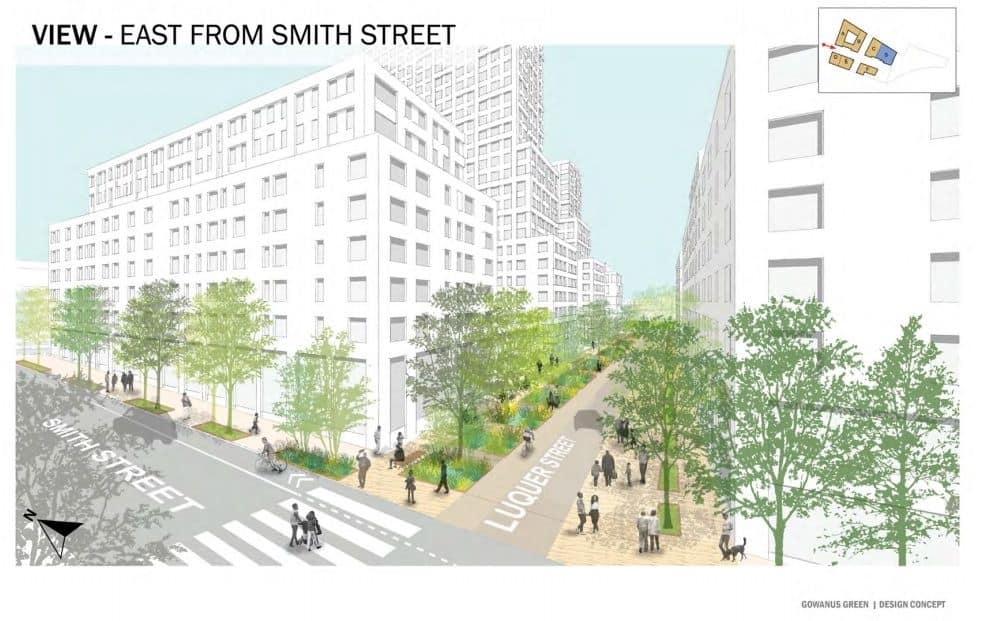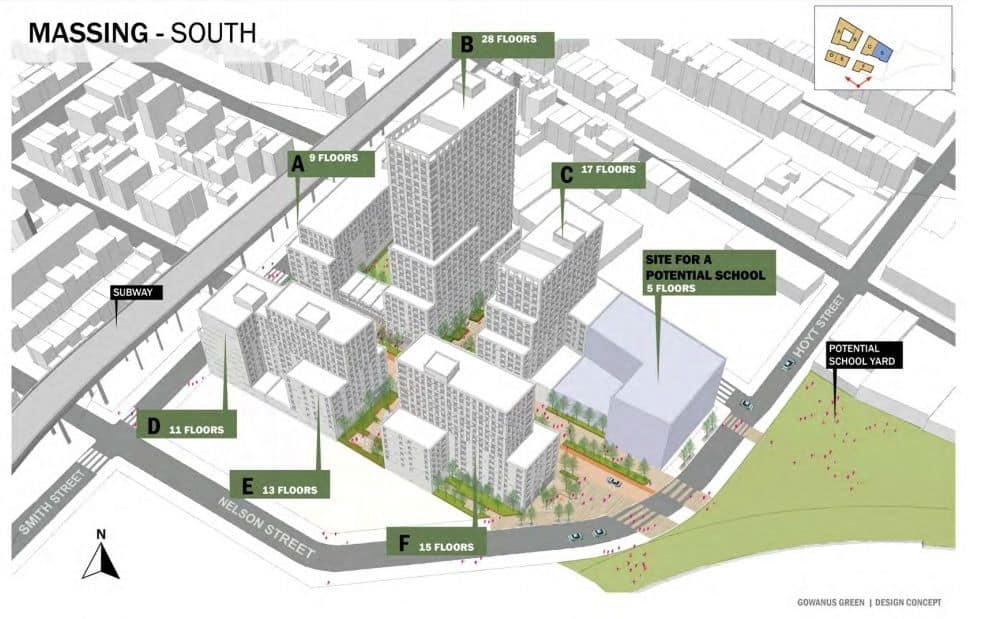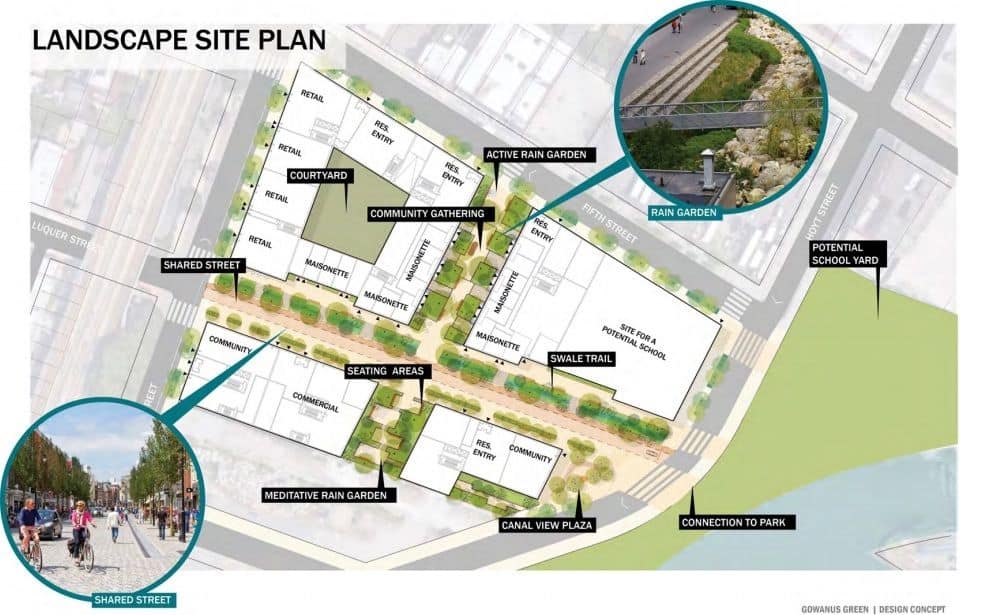On December 2, in the auditorium of PS 32, Community Board 6 (CB6) got to hear the latest on Gowanus Green, the long-delayed project that’ll convert 247,877 square feet of polluted land into a mixed-use development topping out at 28 stories, with housing, green space, and a public school. For a variety of reasons, a lot of Gowanus residents in the audience didn’t like what they heard.
Gowanus Green began its conceptual life in 2007 as a Request for Proposals issued by the New York City Department of Housing and Preservation (HPD) for the redevelopment of the former site of manufactured gas plant (then known as “Public Place”) at the corner of Smith and 5th streets, extending below Liquer Street and past Hoyt Street to the Gowanus Canal. HPD asked for a plan “with a mixture of residential (market rate and affordable), neighborhood retail space, parking, community facility space, and waterfront parkland.” Following a soil cleanup paid for by National Grid, the developer would aim for a 2017 completion date.
In 2008, the Bloomberg administration awarded the project to Hudson Companies, Jonathan Rose Companies, Bluestone Organization, and the nonprofit Fifth Avenue Committee, which together would take ownership of the city’s land. Two years later, when the EPA affirmed the area’s toxicity by designating the Gowanus Canal a Superfund site, the development team determined to push forward with Gowanus Green, though HPD’s confidence appeared to waver. A second wrinkle emerged when the Department of City Planning revealed that it would rezone the Gowanus neighborhood, rewriting the land use rules for hundreds of parcels near the canal to encourage new construction. Under the expected terms of the larger ULURP, Gowanus Green – already a major undertaking – would have the opportunity to grow even bigger. The developers went back to the drawing board, and by 2019, 774 planned residential units had turned into 950, as the team disclosed in December.
At the presentation, many CB6 residents refused to accept that soil permanently contaminated by coal tar at a depth of 153 feet – beyond the reach of the New York State Department of Environmental Conservation’s excavation – could ever provide a suitable site for a children’s school. Despite a 17-foot ground floor elevation and resilient landscaping, some considered the project a flood risk. A majority in the room appeared to disapprove of Gowanus Green on the grounds of scale alone: they didn’t want seven massive new buildings in their backyard, despite setbacks that’ll shift much of their bulk away from Smith Street.
Affordability a mystery
For their part, the developers emphasized that Gowanus Green will come with plenty of amenities – notably the school and park, but also a number of smaller gathering places, rain gardens, space for retail and community facilities, and improvements to the street grid, which will connect Liquer and Nelson streets to Hoyt Street. The other major public benefit will be the affordable housing. But how much of it will be affordable, and how affordable will it be?
In its various incarnations, projected affordability levels for Gowanus Green have varied, jumping up and down without explanation. HPD’s Request for Proposals attached affordability requirements to 50 percent of the standard residential units (without, however, demanding any units set aside for New Yorkers earning less than 80 percent of Area Median Income, or AMI) and asked the developer to make an unspecified number of senior units available exclusively to elderly people with incomes below 60 percent of AMI.
By the time HPD released a Draft Scope of Work for an Environmental Impact Statement for Gowanus Green in 2008, the minimum affordability requirements had disappeared, and a maximum number of affordable units had taken their place, as the document promised that no less than 30 percent of the residential units would solicit market rents. Today, an apparently out-of-date description of the project on Jonathan Rose Companies’ website promises that 70 percent of units will be affordable for households earning between 30 percent and 130 percent of AMI.
At the Public Place Community Workshop in 2018, HPD’s Leila Bozorg, Deputy Commissioner of Neighborhood Strategies, made a different claim: full affordability. At the time, BKLYNER reported as follows: “Noting the city’s population growth, significant changes in the real estate market, and ‘a much deeper and broader demand for affordable housing at a range of incomes,’ Bozorg said the project will now provide 100% affordable housing, offering between 850 to 1,000 below-market units. ‘Feeling the effect of that affordability crisis in the city and in Gowanus specifically, we wanted to make sure that we are providing as much affordable housing as we can on some of these scarce public sites.’”
Today, the official website of Gowanus’s councilman, Brad Lander, asserts, in the section of his Gowanus Neighborhood Rezoning FAQ that addresses Gowanus Green, that “all of its 900 units will be affordable housing.” Evidently, Lander, who attended the CB6 meeting, had by December become aware that the developers’ plans had changed once again, and like everyone else in the crowd, he no longer knew what to expect. Alongside other community members, he eagerly pressed the team for details.
Alas, the developers hadn’t yet determined how much affordable housing Gowanus Green would include. But they pledged that no less than 74 percent of the units would be affordable, with the cheapest ones allocated to families making 30 percent of AMI ($32,010 per year for a family of four). The priciest units still bearing an “affordable” designation would go to households earning 120 percent of AMI ($128,040 per year for a family of four), but the majority of Gowanus Green’s affordable housing would be available to those making below 60 percent of AMI ($64,020 for a family of four). HPD sets the rents for New York City’s affordable housing to equal 30 percent of the monthly income of a family in a designated income band – making the apartment “affordable” to eligible applicants, not necessarily to you or me.
Consider the landlord
The development team noted that, because it has yet to finalize the residential component of Gowanus Green, 100 percent affordability remains a possibility, but tellingly, the representatives emphasized that a dose of market-rate housing would help “cross-subsidize” the affordable units – that is, the profits from the luxury apartments would offset the losses from the affordable housing. But an affordable unit for a four-person household at 120 percent of AMI would rent for $3,201 a month – would that price really represent a loss for the landlord, especially after the city has gifted said landlord the deed to six valuable acres of Brooklyn real estate for free?
When CB6 residents objected on December 2, the developers explained that including market-rate housing would benefit everyone because it would mean that private capital would foot the bill for a greater share of the infrastructural upgrades built into the project, reducing the taxpayer’s burden. Without 100 percent affordability, the developers would, in fact, pay an acquisition fee for land’s title – a price in the millions but undoubtedly still much smaller than the market value – instead of obtaining it for free from the city. And instead of receiving a complete property tax exemption, they would have to rely on the 421-a program to limit their tax burden. These modest contributions to the public coffers would help pay for the new streets between Smith and Hoyt, and by ensuring plenty of revenue from at least a few sky-high rents, Hudson Companies could even manage, perhaps, to create a special fund for the maintenance of the new park beside the canal, instead of leaving the Department of Parks and Recreation with the bill.
Did anyone buy this argument? I wouldn’t bet on it.
The important thing to know about Gowanus Green is that it’s the only city-owned site within the Gowanus neighborhood rezoning. This same rezoning will create more than 8,000 new units of predominantly luxury housing for private developers who – buoyed by tax credits and abatements on the city (421-a), state (Brownfield Cleanup Program), and federal (Opportunity Zone) level – will reap hearty profits. New York City needs more housing, and Gowanus, regardless of NIMBY complaints, is a sensible place to put some of it, but adding to a glut of overpriced units won’t help Brooklynites in danger of being priced out of their own borough.
Step up, Brad Lander
Councilmember Lander says he wants 100 percent affordability at Gowanus Green. I’ve criticized him before for putting his faith in gentrification-inducing rezonings as the solution to New York’s housing crisis (rather than fighting for the better, “impossible” goal of social housing), but he has publicly insisted, at least, that he rejects libertarian YIMBYism and instead hopes to join incentives for new residential development with firm rent regulations, strict affordability requirements, and heavy community engagement to ensure stability and accessibility in the housing market for all New Yorkers. His Gowanus rezoning will nevertheless produce an aesthetic nightmare of anonymous condo towers, an array of potential environmental risks, and, in all likelihood, Williamsburg-level rents, but for Lander, New York’s Mandatory Inclusionary Housing policy, which dictates 25 percent affordability for upzoned sites, makes it worthwhile.
Lander acknowledges that it’s a challenge to steer private development toward the public good, but in his view, the new Gowanus will at least reflect a good-faith attempt. In other words, it’s not just a giveaway to real estate kingpins.
But it’s hard to take this defense seriously if Lander won’t commit to an unconditional demand for 100 percent affordability at Gowanus Green. In this case, the city doesn’t have to use its typically limited toolbox to nudge the landowner in the direction of low-income and middle-income housing; the landowner is the city. It can do whatever it wants on the site – it can construct homes exclusively for the populations that need them most. Unfortunately, due to political ideology rather than any practical obstacle, New York City doesn’t directly build its own housing anymore, but if it has to work with a private developer, it can, on a public site, tell the developer exactly what it wants, and if the developer won’t supply it, it can get a new developer.
“The City is under no legal obligation to convey the Development Site offered through this RFP,” HPD carefully noted in its 2007 Request for Proposals. “This RFP does not represent any obligation or agreement whatsoever on the part of the City.” So far, Gowanus Green still belongs to HPD.
When the Gowanus Green developers suggest that 100 percent affordability may not be feasible, what they really mean is that 100 percent affordability might jeopardize their ability to generate private profits off of a public asset. What business does Hudson Companies really have on our property? A responsible HPD would have given Public Place fully to a nonprofit developer of affordable housing, although, to be fair, the median rent in Gowanus even as recently as 2010 was only half what it is today – the meaning of a “market-rate apartment” has changed a lot in the area over the last decade.
Genuinely affordable units have become more essential than ever – Hudson Companies may just not be the right developer to give them to us. Even at this late date, I don’t see why HPD couldn’t start from scratch. The circumstances under which HPD conceived of Gowanus Green no longer exist – it makes no real sense to think of today’s iteration as the same project.
The existing development team is right, of course, that a residential development premised entirely on deep affordability (which the current proposal is not) would require a public subsidy even beyond the gift of the land. New York City should provide that subsidy. Despite the best efforts of government to give developers a free ride, the city will see some kind of increase in tax revenue following the Gowanus rezoning – NYCHA advocates have suggested using “value capture” to improve the local public housing complexes, which need help badly. With enough support, Gowanus Green could become another resource for the same population that NYCHA, before its dramatic decline, once protected.
HPD – not City Council – is in charge of Gowanus Green. But in the end, it’s all in Lander’s hands: if he doesn’t approve the ULURP for the Gowanus neighborhood rezoning, Gowanus Green can’t happen. At CB6, Lander refused to stake his yes vote on a 100 percent affordability requirement at the development. He hopes it’ll happen, but he won’t stick his neck out with a promise to torpedo the whole plan if it doesn’t.
Since Lander will be termed out of City Council at the end of 2021, he’s already begun a campaign for City Comptroller. Voters should take note: if the councilman does not secure full affordability at Gowanus Green, it’ll represent colossal political failure.
Lander has sworn off campaign contributions from for-profit developers for the 2021 election, but his earlier fundraising raises questions about his motivations during the pre-rezoning community planning process, Bridging Gowanus. For instance, in 2014, he accepted $4,750 from the Walentas family of Two Trees Management, now a major landowner in the neighborhood. The fate of the Gowanus rezoning will ultimately determine whether, in his future political endeavors, he’ll have the standing to present himself as a pro-housing progressive or have to endure rightful branding as a servant of the real estate industry.
Councilmember Lander – who has also accepted donations from executives at four of the project leads on Gowanus Green ($1,350 from Jonathan Rose Companies, $1,100 from the Fifth Avenue Committee, $500 from Marvel Architects, and $250 from Hudson Companies) – must do whatever it takes to ensure full affordability at Gowanus Green. His rezoning will do plenty for private developers in Gowanus – at the very least, Gowanus’s Public Place, if indeed it’s safe for construction at all, should be developed entirely for the good of the public.











